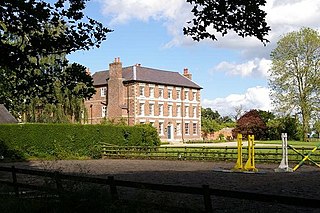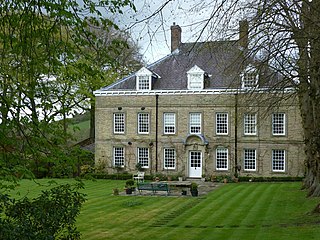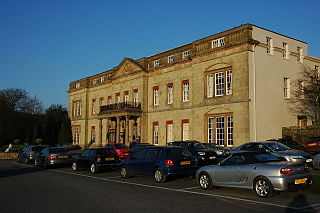
Lyme Park is a large estate south of Disley, Cheshire, England, managed by the National Trust and consisting of a mansion house surrounded by formal gardens and a deer park in the Peak District National Park. The house is the largest in Cheshire, and is recorded in the National Heritage List for England as a designated Grade I listed building.
Betchton Hall is a country house in the parish of Betchton, Cheshire, England. It was originally a timber-framed house, and was substantially rebuilt in brick in the 18th century for Richard Jackson, prebendary of Chester. In the early years of the following century it was extended for Richard Galley. The house is in two storeys. The southeast front has seven bays that include a round-headed doorway. The southwest front has three bays, and contains Venetian windows. The entrance hall is circular. In the house is an 18th-century fireplace moved from Faringdon House, then in Berkshire and now in Oxfordshire, in the 1960s. The house is recorded in the National Heritage List for England as a designated Grade II listed building.

Bostock Hall is a country house to the northeast of Winsford, Cheshire, England. A former Georgian house, it was rebuilt in 1775 for Edward Tomkinson. It is thought that the architect was Samuel Wyatt. Alterations and additions were made to it in the middle of the 19th century and in 1875. The house is constructed in brick with ashlar dressings; it has a slate roof. It is in three storeys plus a basement. Its plan is L-shaped. The entrance front has a central bow window rising through all floors, and a single-storey porch with a balustraded parapet. The garden front has two bows, between which are a Venetian window with a Diocletian window above. The house is recorded in the National Heritage List for England as a designated Grade II* listed building.

Bulkeley Hall is a country house to the southwest of the village of Bulkeley, Cheshire, England. It dates from the middle of the 18th century, and was built for Thomas Bulkeley. The house is constructed in brick with a slate roof. Its architectural style is Georgian. The entrance front has three storeys, and is in seven bays. A service wing at right-angles gives it an L-shaped plan. The interior contains 18th-century plasterwork and joinery. The house is recorded in the National Heritage List for England as a designated Grade II* listed building.

Davenham Hall is a former country house to the southeast of the village of Davenham, Cheshire, England. It was built for Thomas Ravenscroft to replace a timber-framed house called Davenham Lodge. It dates from the middle or the later part of the 18th century, possibly from shortly before 1795, when Ravenscroft died. Substantial additions were made in the early 19th century. It is constructed in stuccoed brick, and has a slate roof. The house is in two storeys with a symmetrical entrance front of six bays. Occupying the middle two bays is a porch with four Tuscan columns and an entablature containing a triglyph. Above this, the central bays protrude slightly forwards and contain two windows, with a pediment above them and a parapet on each side. Figueirdo and Treuherz describe the interior as being "especially fine". The entrance hall contains Grecian plasterwork and a black marble chimneypiece. The drawing room has more delicate plasterwork, and a marble chimneypiece decorated with dancing figures. The central staircase hall is lit by a central dome, and has fan-shaped plasterwork. The staircase has a wrought iron baluster, and the first floor landing has a screen of four Doric columns. The house was converted into a nursing home in 1980. It is recorded in the National Heritage List for England as a designated Grade II* listed building.

Hassall Hall is a former manor house to the east of the village of Hassall, Cheshire, England. The house dates from the 17th century, and was re-fronted in the 19th century. It has since been divided into two houses. It is constructed in rendered brick and has a slate roof. The house has an H-plan. The entrance front is symmetrical, in two storeys, with five bays. The central three bays are recessed and the middle bay contains a doorway. The doorway is flanked by Tuscan pillars, and above the door is an open pediment enclosing a fanlight. The houses are recorded in the National Heritage List for England as a designated Grade II* listed building.

Langley Hall is a country house in the village of Langley, Cheshire, England. It was built in about 1650, and is described by the authors of the Buildings of England series as "a distinguished house". The house is constructed in coursed rubble with ashlar dressings and is roofed in stone slate. It has two-storeys and an attic. The entrance front is symmetrical with seven bays and a central doorway. Above the doorway is a cartouche containing a carved face. It is inscribed MAC 1696. The house is recorded in the National Heritage List for England as a designated Grade II* listed building. It has been converted into three flats.

Lea Hall is a former country house standing to the northwest of the village of Wimboldsley, Cheshire, England. It dates from the early part of the 18th century, and was built for the Lowndes family. During the 19th century the house was owned by Joseph Verdin. Additions, including dormer windows, were made in the 19th century. During the 20th century the house was divided into three flats. The house is constructed in red brick with ashlar dressings and a tiled roof. It is in two storeys, with an attic and a basement. The roof is large and hipped, with a viewing platform. The entrance front is symmetrical, in five bays, the central bay protruding slightly forward. This bay contains a doorway with a swan's nest pediment decorated with scrolls, and containing a crest with the initials J V. The authors of the Buildings of England series describe the house as a "perfect brick box, delightful if just a little funny to look at". It is recorded in the National Heritage List for England as a designated Grade II* listed building.

Middlewich Manor is a former manor house in Middlewich, Cheshire, England. It was originally constructed in brick in about 1800, and it was encased in ashlar in about 1840, when the porch was also built The bay windows were added in the 1870s. As of 2011, it is a residential care home. The house is constructed in yellow ashlar and is in two storeys. On its entrance front is a porch supported by four fluted Ionic columns. Along the top of the porch is a frieze and a cornice. On each side of the porch are two-storey canted bay windows. Between the stories is a band of Greek keys. A parapet runs along the top of the house, behind which is a low-pitched roof. On the garden front there are sash windows and a canted two-storey bay window to the right, and a wing with a stone oriel window and a pyramidal slated roof to the left. There is more decoration with bands of Greek keys on this front. The house is recorded in the National Heritage List for England as a designated Grade II listed building.

Ollerton Hall is a country house in the village of Ollerton, Cheshire, England. Its nucleus dates from the 17th century, originally on an H-plan, followed by a succession of "rambling extensions". A plaque over the entrance is inscribed with the initials THP" and the date 1728. The house was built originally for the De Baguley family. The building is constructed in rendered brick with a slate roof. It is in two storeys and, with the later extensions, has an E-plan. The entrance front has five bays, the central bay projecting forward with a gable. At each end is a gabled cross wing. The windows are a mixture of sashes and casements. The house is recorded in the National Heritage List for England as a designated Grade II listed building.
Oughtrington Hall was a country house located in Oughtrington Lane to the east of the village of Lymm in Cheshire, England.

Shrigley Hall is a former country house standing to the northwest of the village of Pott Shrigley, Cheshire, England. It has since been used as a school, when a chapel was added, and later as a hotel and country club operated by The Hotel Collection.

Stretton Hall is a country house in the parish of Stretton in Cheshire, England. It was built in about 1763 for John Leche. The house is constructed in brick on a sandstone basement, with painted stone dressings, and a slate roof. It has three symmetrical elevations. The entrance front is in three two-storey bays with a single-storey wing on each side. The central bay is canted, with five steps leading up to a doorway with a pediment. The windows are sashes. The garden front has similar windows, other than the wings, each of which contains a Venetian window. To the right of the house is attached a further wing, converted from the 17th-century stable of an earlier house. The house and former stable area is recorded in the National Heritage List for England as a designated Grade II* listed building. The sandstone garden walls are listed at Grade II.
Swettenham Hall is a country house standing to the southeast of the village of Swettenham, Cheshire, England. It dates from the 17th century and was remodelled in the 19th century. The house is constructed in pebbledashed brick on a stone plinth with a slate roof. It has a symmetrical façade in seven bays. The central bay has a single-storey canted bay window, and the second and sixth bays have two-storey canted bay windows. All the windows are sashes. At the rear of the house is a large three-bay canted bay window containing three pairs of French windows, above which are gables. The house is recorded in the National Heritage List for England as a designated Grade II listed building. Also listed at Grade II is a range of farm buildings to the east of the hall dating from the middle of the 18th century, and a private chapel to the northwest of the hall built in 1852.
Tushingham Hall is a country house in Tushingham, Cheshire, England. Formerly a moated farmhouse, it was remodelled in the early 19th century for Daniel Vawdrey, retaining many 17th-century features. It is constructed in rendered brick with slate roofs. Its architectural style is Tudor Revival. The house is in two storeys with a symmetrical entrance front. The centre of the front is recessed and contains a canted open porch with three Tudor arches. Above this is a mullioned window containing two sashes. On each side is a similar window in both storeys, those in the upper storey being smaller than those below. Above the window over the porch is a shaped gable containing a wreath, and the rest of the front is crenellated. The interior contains a 17th-century staircase originally in Dearnford Hall, Staffordshire. The house is recorded in the National Heritage List for England as a designated Grade II listed building.
Twemlow Hall is a country house standing on a former moated site in the parish of Twemlow, Cheshire, England. It dates from the 17th century, and was "much altered" in 1810 for William Bache Booth. It was altered again in 1974. The house is constructed in brick on a stone plinth. It has flush stone quoins and a slate roof. It has two storeys, and a symmetrical entrance front of five bays, three of which are gabled. Above the doorway are the arms of the Booth family. The windows are sashes. The house is recorded in the National Heritage List for England as a designated Grade II listed building. Three structures associated with the hall forming three sides of a former stable yard are also listed at Grade II.
Weaver Hall is an English country house in the parish of Darnhall, Cheshire. It was built in the early 17th century, largely rebuilt in the early 18th century, and remodelled in 1847. The house is constructed in brick with a slate roof. It has an H-shaped plan, and is in three storeys plus an attic. The entrance front has projecting gabled wings. The left wing contains two two-light windows in each storey, and a circular window in the gable. The interior has a baffle entry. The house is recorded in the National Heritage List for England as a designated Grade II listed building.

Whirley Hall is a country house standing to the north of the village of Henbury, Cheshire, England. The house dates from about 1670. Additions and alterations were made during the 18th century and in the 1950s, when the house was restored and wings were added at the sides. The house is constructed in brick with buff sandstone dressings, and has a Kerridge stone-slate roof with stone ridges. It has three storeys and symmetrical five-bay front. Between the storeys, and above the top storey, are brick bands. The lower two storeys contain 20th-century wooden-framed mullioned and transomed windows. In the top storey are two-light casement windows. Above these are two shaped gables, each surmounted by an obelisk finial, and containing an elliptical window. There are single-storey, two-bay extensions on each side of the house. In the roof of the house is a stone inscribed with the date 1599, which is considered to have been removed from an earlier timber-framed house. The house is recorded in the National Heritage List for England as a designated Grade II* listed building. The gate pier in front of the house is a Grade II listed building.
Willaston Hall is a country house in the village of Willaston, near Nantwich, in the unitary authority of Cheshire East, England.
Willot Hall is a country house in the parish of Prestbury, some 4.5 km to the east of Wilmslow, Cheshire, England. It originated as a medieval hall house in the later part of the 15th century. This was encased in stone in the 17th century. Later in the century a service wing was added. The house was restored and extended between 1933 and 1939, moving the entrance and reopening the great hall to the roof. It is constructed partly in buff sandstone rubble and partly in brick, with Kerridge stone slate roofs. It is in 2½ storeys, with a four-bay entrance front, the left bay being larger than the others. The left bay contains mullioned windows and is gabled. The other bays contain a doorway, smaller mullioned windows, and have gabled dormers. The house is recorded in the National Heritage List for England as a designated Grade II* listed building.












